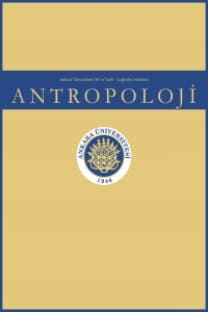Tafonomide Uniformitarianizm, Middle-Range Teori ve aktüalistik çalışmalar
Biyolojik antropolojide geçmişteki statik ve dinamikler arasındaki ilişkiyi nedensellik çerçevesinde anlamak, geçmiş hakkında anlamlı açıklamalar yapmak için oldukça önemlidir. Birçok bilim insanının yaptığı gibi biyolojik antropologlar da geçmişi teoriler ile açıklamaya çalışırlar. Bu çalışmada geçmişi anlamak için üzerinde durulan paradigmalar olarak uniformitarianizmin ve middle-range teorinin biyolojik antropolojideki ve özellikle tafonomideki yerine ve önemine değinilecektir.
Anahtar Kelimeler:
Tafonomi, middle-range teori, uniformitarianizm, paleontoloji, arkeoloji
Uniformitarianism, Middle-Range Theory and actualistic studies in Taphonomy
In biological anthropology, it is crucial to understand the relationship between the static and dynamics of the past within the framework of causality in order to make meaningful explanations about the past. Like many other scientists, biological anthropologists try to explain the past with theories. In this study, the place and importance of uniformitarianism and middle-range theory in biological anthropology and especially in taphonomy will be discussed as paradigms emphasized to understand the past.
Keywords:
Taphonomy, middle-range theory, uniformitarianism, paleontology, archaeology,
___
- Andrews, P., ve Cook, J. (1985). Natural modifications to bones in a temperate setting. Man, 20(4), 675-691. https://doi.org/10.2307/2802756
- Benito-Calvo, A., Crittenden, A. N., Livengood, S. V., Sánchez-Romero, L., Martínez-Fernández, A., de la Torre, I., ve Pante, M. (2018). 3D 360 surface morphometric analysis of pounding stone tools used by Hadza foragers of Tanzania: A new methodological approach for studying percussive stone artefacts. Journal of Archaeological Science: Reports, 20, 611-621. https://doi.org/10.1016/j.jasrep.2018.06.003
- Blumenschine, R. J. (1988). An experimental model of the timing of hominid and carnivore influence on archaeological bone assemblages. Journal of Archaeological Science, 15(5), 483-502. https://doi.org/10.1016/0305-4403(88)90078-7
- Blumenschine, R. J. (1995). Percussion marks, tooth marks, and experimental determinations of the timing of hominid and carnivore access to long bones at FLK Zinjanthropus, Olduvai Gorge, Tanzania. Journal of Human Evolution, 29(1), 21-51. https://doi.org/10.1006/jhev.1995.1046
- Binford, L. (1981) Bones: Ancient men and modern myths. Academic Press. https://doi.org/10.1016/C2013-0-07180-0
- Capaldo, S. D. (1995). Inferring hominid and carnivore behavior from dual-patterned archaeofaunal assemblages [Yayımlanmamış doktora tezi]. Rutgers The State University of New Jersey, School of Graduate Studies.
- Fernández-Jalvo, Y. (2003). Experimental effects of water abrasion on bone fragments. Journal of Taphonomy, 1(3), 145-161.
- Gaudzinski-Windheuser, S., Kindler, L., Rabinovich, R., ve Goren-Inbar, N. (2010). Testing heterogeneity in faunal assemblages from archaeological sites. Tumbling and trampling experiments at the early-Middle Pleistocene site of Gesher Benot Ya’aqov (Israel). Journal of Archaeological Science, 37(12), 3170-3190. https://doi.org/10.1016/j.jas.2010.07.018
- Gould, S. J. (1965). Is uniformitarianism necessary?. American Journal of Science, 263(3), 223-228. https://ajsonline.org/article/61297-is-uniformitarianism-necessary
- Gümrükçü, M., ve Pante, M. C. (2018). Assessing the effects of fluvial abrasion on bone surface modifications using high-resolution 3-D scanning. Journal of Archaeological Science: Reports, 21, 208-221. https://doi.org/10.1016/j.jasrep.2018.06.037
- Lyman, R. L. (1994). Vertebrate taphonomy. Cambridge University Press. https://doi.org/10.1017/CBO9781139878302
- Pante, M. C. (2013). The larger mammal fossil assemblage from JK2, Bed III, Olduvai Gorge, Tanzania: implications for the feeding behavior of Homo erectus. Journal of human evolution, 64(1), 68-82. https://doi.org/10.1016/j.jhevol.2012.10.004
- Pante, M. C., ve Blumenschine, R. J. (2010). Fluvial transport of bovid long bones fragmented by the feeding activities of hominins and carnivores. Journal of Archaeological Science, 37(4), 846-854. https://doi.org/10.1016/j.jas.2009.11.014
- Pante, M. C., Blumenschine, R. J., Capaldo, S. D., ve Scott, R. S. (2012). Validation of bone surface modification models for inferring fossil hominin and carnivore feeding interactions, with reapplication to FLK 22, Olduvai Gorge, Tanzania. Journal of Human Evolution, 63(2), 395-407. https://doi.org/10.1016/j.jhevol.2011.09.002
- Pante, M. C., Scott, R. S., Blumenschine, R. J., ve Capaldo, S. D. (2015). Revalidation of bone surface modification models for inferring fossil hominin and carnivore feeding interactions. Quaternary International, 355, 164-168. https://doi.org/10.1016/j.quaint.2014.09.007
- Selvaggio, M. M. (1998). Evidence for a three-stage sequence of hominid and carnivore ınvolvement with long bones at FLK Zinjanthropus, Olduvai Gorge, Tanzania. Journal of Archaeological Science, 25(3), 191-202. https://doi.org/10.1006/jasc.1997.0281
- Shipman, P., ve Rose, J. (1983). Early hominid hunting, butchering, and carcass-processing behaviors: approaches to the fossil record. Journal of Anthropological Archaeology, 2(1), 57-98. https://doi.org/10.1016/0278-4165(83)90008-9
- Shipman, P., ve Rose, J. J. (1988). Bone tools: An experimental approach. S. L. Olsen (Ed.) içinde, Scanning electron microscopy in archaeology (s. 303-335). British Archaeological Reports.
- Simpson, G. G. (1970). Uniformitarianism. An inquiry into principle, theory, and method in geohistory and biohistory. M. K. Hecht, ve W. C. Steere (Ed.) içinde, Essays in evolution and genetics in honor of Theodosius Dobzhansky: A supplement to evolutionary biology (s. 43-96). Springer US. https://doi.org/10.1007/978-1-4615-9585-4_2
- ISSN: 0378-2891
- Yayın Aralığı: Yılda 2 Sayı
- Başlangıç: 1963
- Yayıncı: Ankara Üniversitesi Basımevi
Sayıdaki Diğer Makaleler
Cebirli Omurgalı Fosil Lokalitesi kazı çalışmaları
Cumhuriyetin 100. yılında insanlık tarihine damgasını vuran Çorakyerler Omurgalı Fosil Kazısı
Tafonomide Uniformitarianizm, Middle-Range Teori ve aktüalistik çalışmalar
Yeşil ergonomi: Ergonomiye ekolojik bir yaklaşım
Mikro aşınma ve beslenme ilişkisi
Antropolojik “bilimselciliğin” sorunlarının keşfedildiği bir yolculuk: “Dinin tanımı” tartışması
